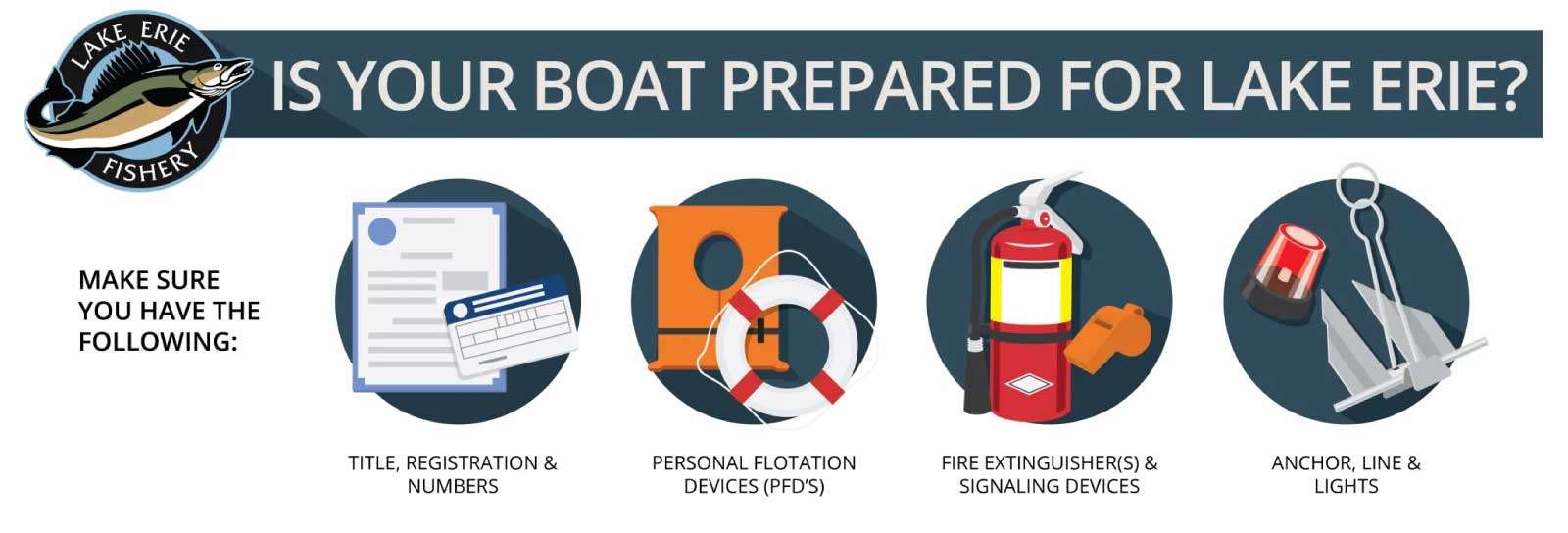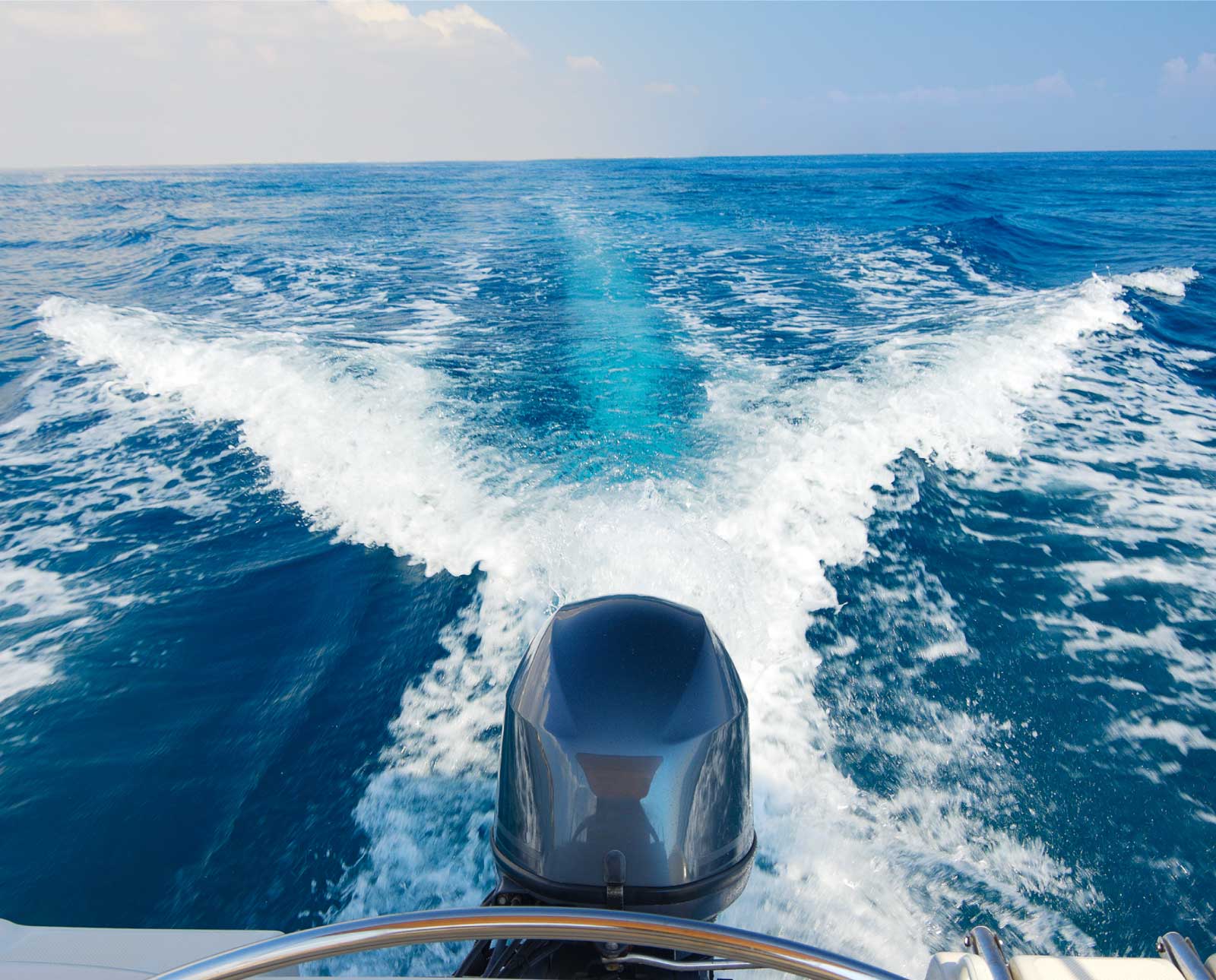Follow these guidelines and checklist to make sure your boat is properly prepared for Lake Erie
You’ve been to the bait shop, assembled your fishing gear, purchased your Ohio Fishing License and are eager to cast a line or two (or more!) and start chasing walleye on Lake Erie. The excitement is building as everyone loads into the car and gets ready to head out on your new Great Lakes adventure. But before you ever launch, it’s a good idea to pause and ask the question: are I and my watercraft ready to deal with everything a Great Lake can throw at us – literally and figuratively?
Let’s walk through some basics that will prevent issues and ensure you get the most enjoyment out of your Lake Erie walleye adventure. The basic checklist is:
- Get all the equipment as required by both Federal and local rules.
- Know what it takes to operate your watercraft safely on Lake Erie.
- Trip preparation is key: Maintenance, Planning, Weather.
- Do not forget the fishing stuff.
- Have a pre-launch checklist/ritual.
Get all the boating equipment as required by both federal and local rules.
Every watercraft has equipment that must be on board, based on Federal and/or local rules. Even personal watercraft, such as jet skis and kayaks, have equipment requirements. This includes items such as U.S. Coast Guard (USCG) approved life jackets for each passenger, throw cushions, fire extinguishers, a sound signaling device, lights and more – depending on the size of your watercraft. Make sure items such as fire extinguishers and flares are not expired, and check that nothing is torn, waterlogged or otherwise damaged. And since Lake Erie and its connecting bays and harbors are Federal waters, you will need to meet all minimum Federal Requirements along with any local requirements.
The good news is that both The Ohio Division of Natural Resources and the USCG have checklists of required equipment you can access on their websites, which makes it easy to know exactly what you need.

Know what it takes to operate your watercraft safely on Lake Erie.
If you’re like us, once the Lake Erie Walleye bug has bitten, there is nothing you’d rather do with your free time. Still, it is important to understand how to spend your time on the water safely. In their 2021, Recreational Boating Statistics Report, the US Coast Guard reported there were over 4,000 boating accidents across US waters in the United States. Among the top 10, primary contributing factors to these accidents were operator inexperience, not following navigation rules, and other preventable causes.
The US Coast Guard offers numerous resources, from online classes to checklists through their website uscgboating.org where you can educate yourself. Your adventures will be more pleasurable for everyone if you first ensure you have a solid foundation on what it takes to operate your watercraft safely. It is a resource worth checking out.
Boat trip preparation is key: Maintenance, Planning, Weather.
Every Lake Erie Captain will tell you that the key to a successful and enjoyable trip comes down to good preparation. Preparation can be placed in two buckets; preventative actions and actions you put in place “just in case” something goes wrong.
Prevention actions are all about maintenance. Make sure your watercraft, trailer and equipment are current and not in need of any maintenance. If your watercraft is powered, that includes the engines and batteries. Bilge pumps, plugs and seals should be checked every trip. And as mentioned, you should regularly check your required safety equipment to verify it’s still functional.
But what will you do if your battery dies, or you have engine trouble while on the lake? Think it can’t happen? Unfortunately, we’re here to say that it happens to even the best of us. Preparing for “just in case” is invaluable.
In the end, the most important thing is making sure you have a “float plan” in place. A USCG-registered Float Plan will include a description of the vessel, number of people on board, your destination, contact information and timeframe of the outing. For a recreational outing, a good plan can be as simple as letting family or friends know exactly where, when and with whom you are going. Deciding if you need a full USCG float plan can depend on how far you are going, the weather, and even the season. You can find more information on float plans on the USCG Discover Boating website via the resources below.
And on Lake Erie, even the most epic fishing adventures are subject to watercraft suitability and weather. As you are planning your trip, ask yourself a few critical questions: Where do I want to go? What is the weather forecast and wind direction? Is my watercraft suited for the location and conditions?
Harbors and protected shorelines are considered safe refuse, so staying close to these locations is suitable for any watercraft from kayaks to larger boats. When fishing further offshore, a deep V hulled boat 18 feet or larger is needed. Smaller power boats under 18 feet may be able to venture a bit off the protected shoreline areas depending on the captain’s experience and weather conditions.
Our strategy for handling weather is two to three days before our trip we make a preliminary plan on where to fish based on the forecast. On the day of the trip, we’re prepared to adjust that location based on the forecast for that day. We rely on the NOAA nearshore and open lake forecasts which provide specific marine forecasts and data. We also utilize the Windy.com app as a second source of weather data. Any forecast with a chance of thunderstorms, high winds, or a combination of the two is a warning signal that you should be alert and possibly consider a change of plans.
Fishing Gear for Lake Erie
Yes, we are talking about our watercraft here, but as we head out for a day of walleye fishing make sure you run through what gear you will need to maintain on your vessel. It goes without saying that the gear you bring should be appropriate for the size of your watercraft as well. Our equipment suggestions for effective, safe, and humane walleye harvesting are:
- Fish Finding Equipment
- Live well, cooler with ice and/or stringers
- Pliers, Hemostats, Knife, “bonker”, towels.
Have a pre-launch boat checklist/ritual.
There can be a lot to keep in order when you launch any watercraft. When you add the excitement of going fishing and the hurried rush at the dock, there is a risk of forgetting something. We’ve found having a checklist or ritual keeps our heads in the game on what needs to be done before we focus on the fishing. We use this process from the moment we start packing bags and attach our trailer to our truck through launch and retrieval. The West Marine and USCG Discover Boating sites have examples of checklists to reference which you can access through our resource links. Our suggestion would be to use theirs and make one of your own to fit your equipment and situation.
Here are a few other tips from the experts to ensure you and your boat is Lake Erie savvy.
- Have a place to stash some personal items & gear. Whether it’s a cell phone, go pro camera, or sunscreen we all have those few things we need. Depending on watercraft size this could be a spot for a waterproof backpack under your seat or actual hatches that latch.
- For many of us, a good set of lines, a boat hook, and bumpers are your best friend. Take it from our experience, they can save you from lots of frustration, stress, scratches, and damage.
- Readily seek out a USCG Vessel check. Officers are routinely available at launches and looking to do courtesy inspections of vessels. If they approach you and ask if you have time for an inspection say, yes.
- If you plan on venturing offshore or fishing through cold water seasons, make you’re your gear is appropriate for the weather. You may find you need bibs or even a survival suit in case of emergency.
- Having a cell phone with you for emergencies is great. If you don’t have a marine radio on board, we recommend investing in a handheld radio to take it to the next level.
- Before you launch always verify the plug is in place securely. And if your watercraft has a bilge once you’ve launched check it to ensure it’s free of water while you are still in sight of the docks.
- For beginner boaters a tough docking skill commonly faced is wind. Start by using the wind as your docking friend. Put the bumpers on your downwind (port or starboard) side and slowly come in letting the wind naturally take you toward the dock eliminating the state of panic that comes with being pushed away.
- When it comes to weather, Lake Erie is capable of some rough conditions so never be afraid to cut a day short and go to port if there is any sight of impending weather.
Skip the Guessing and get your Guide Approved “Safe Boating” checklist here: https://go.powderhook.com/safeboatingchecklist



